In the world of manufacturing, plastics play a critical role due to their versatility and wide range of applications. However, when selecting the right type of plastic for your project, it's essential to understand the differences between two key categories: thermoplastics and thermosetting plastics. These materials exhibit distinct characteristics, making them suitable for different applications. This guide will provide an in-depth comparison of thermoplastics and thermosetting plastics, helping you make informed decisions based on your needs.
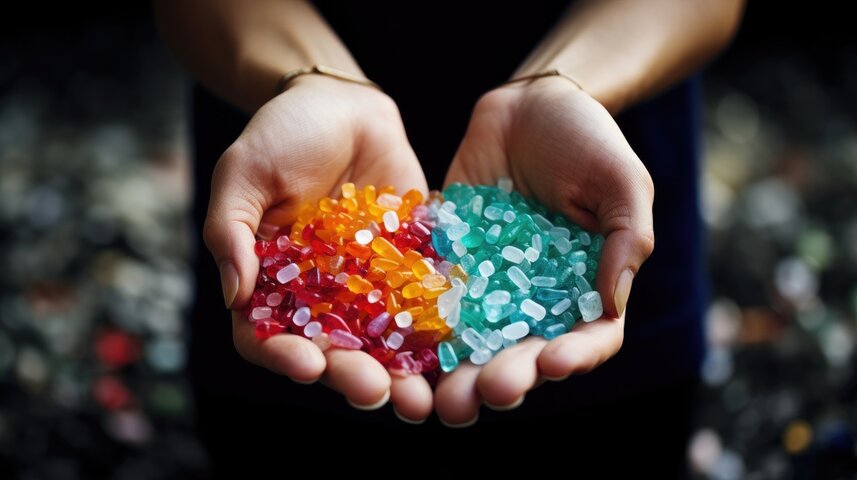
Definition and Basic Properties
Thermoplastics
Thermoplastics are a type of plastic that can be reheated, melted, and reshaped multiple times. They have a linear polymer structure with secondary molecular bonds.
These bonds allow the material to soften when heated and solidify when cooled, without changing its chemical composition. It's similar to how water can change from liquid to solid (ice) and back again.
Key properties of thermoplastics include:
Low melting point
Recyclability
Flexibility
Impact resistance
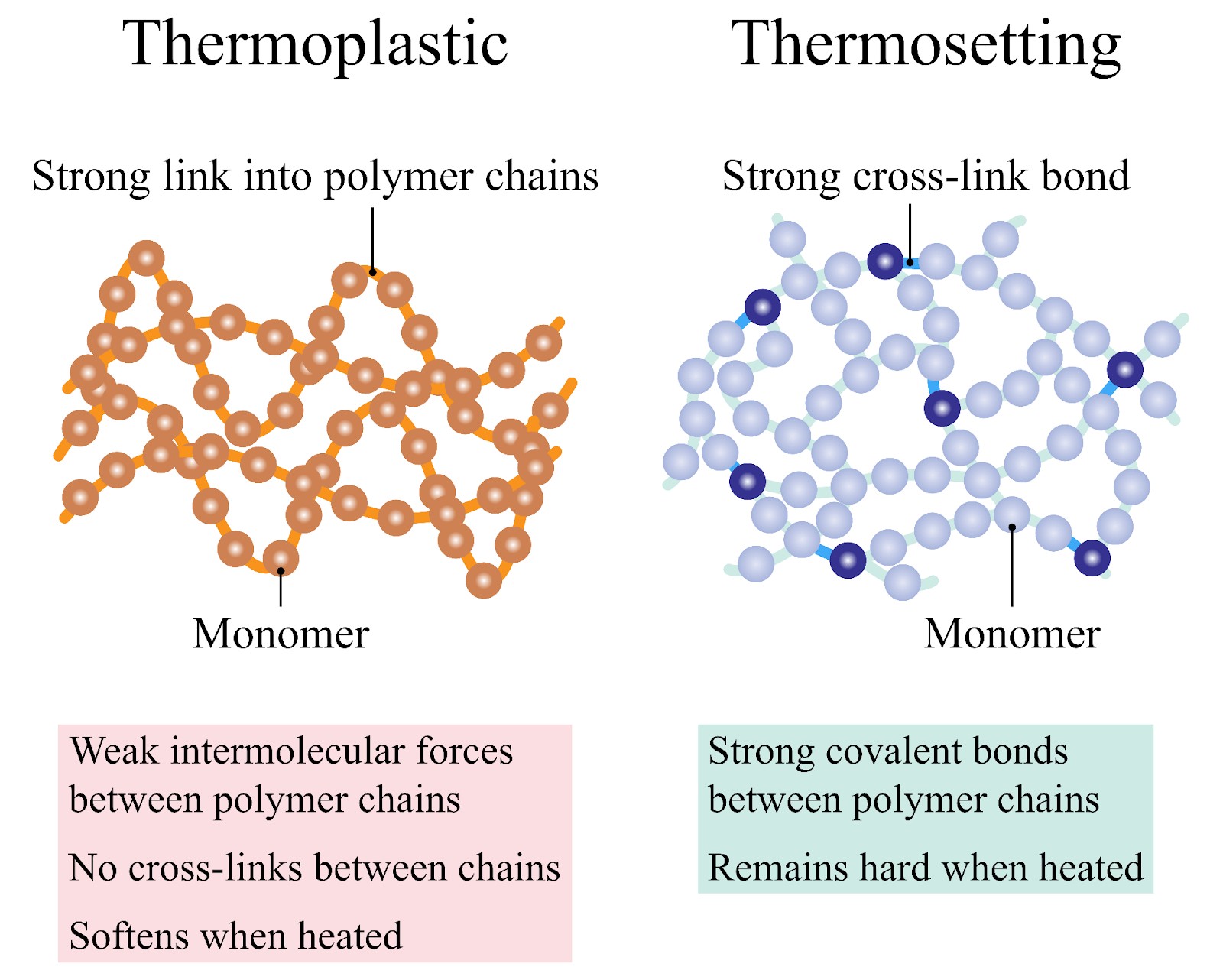
Thermosetting Plastics
Thermosetting plastics, or thermosets, are plastics that harden permanently after being heated. Unlike thermoplastics, they cannot be melted and reshaped once they have been cured.
Thermosets have a network polymer structure with strong molecular bonds (cross-linking). These cross-links form during the curing process, creating an irreversible chemical change.
Think of it like baking cookies. Once the dough is baked, it can't be turned back into dough again.
Characteristics of thermosetting plastics include:
High melting point
Rigidity
Durability
Synthesis Methods for Thermoplastics and Thermoset Materials
Thermoplastics and thermoset materials are both polymers. However, they are synthesized through different polymerization processes.
Synthesis of Thermoplastics: Addition Polymerization
Thermoplastics are synthesized through addition polymerization. In this process, monomers are linked together without the formation of byproducts.
The monomers used in addition polymerization typically contain double bonds. When exposed to heat, pressure, or catalysts, these bonds break. This allows the monomers to form long, linear chains.
Synthesis of Thermoset Materials: Condensation Polymerization
Thermoset materials are synthesized through condensation polymerization. In this process, monomers react to form polymers, releasing small molecules (such as water) as byproducts.
The monomers used in condensation polymerization have functional groups at their ends. These groups react with each other, forming covalent bonds between the monomers.
As the reaction progresses, the monomers form a three-dimensional network structure. This cross-linked structure is what gives thermoset materials their rigidity and heat resistance.
The synthesis method plays a crucial role in determining the final properties of the polymer. Addition polymerization leads to the formation of thermoplastics, while condensation polymerization results in thermoset materials.
Manufacturing Processes
Thermoplastics and thermoset materials are processed using different manufacturing techniques. The choice of method depends on the material properties, desired shape, and end-use requirements.

Thermoplastic Manufacturing
Injection molding: Melted thermoplastic is injected into a mold cavity under high pressure. It then cools and solidifies into the desired shape.
Extrusion: Thermoplastic is melted and forced through a die to create continuous profiles like pipes, sheets, or filaments.
Thermoforming: A thermoplastic sheet is heated and formed over a mold using vacuum or pressure. It's commonly used for packaging and signage.
Blow molding: A hollow thermoplastic tube (parison) is inflated inside a mold. It takes the shape of the mold as it cools. This process is used to make bottles and other hollow containers.
Rotational molding: Thermoplastic powder is placed inside a heated, rotating mold. The powder melts and coats the mold's interior, creating hollow parts like tanks and toys.
Thermoset Manufacturing
Reaction injection molding (RIM): Two reactive components are mixed and injected into a mold. They chemically react to form a cross-linked polymer network.
Compression molding: A pre-measured amount of thermoset material is placed in an open, heated mold. The mold closes under pressure, forcing the material to fill the cavity and cure.
Resin transfer molding (RTM): Reinforcing fibers are placed in a mold, and low-viscosity thermoset resin is injected under pressure. The resin impregnates the fibers and cures to form a composite part.
Thermoplastic manufacturing processes involve melting and shaping the material, which then solidifies upon cooling. Thermoset manufacturing, on the other hand, relies on chemical reactions to cure the material into its final shape.
For more specific manufacturing processes, you can explore:
These manufacturing processes are widely used in various industries, including automotive, aerospace, and consumer goods manufacturing.
Properties Comparison: Thermoplastics vs Thermosets
Thermoplastics and thermosets have distinct properties that make them suitable for different applications. Let's compare their key characteristics:
| Property | Thermoplastics | Thermosets |
| Melting Point | Lower, softens and reshapes when heated | Higher, does not melt, only chars or degrades |
| Recyclability | Recyclable, can be remolded multiple times | Non-recyclable, cannot be reshaped after curing |
| Molecular Structure | Linear polymers, weaker secondary molecular bonds | Cross-linked network polymers, strong primary bonds |
| Heat Resistance | Lower, softens under heat | High, resistant to high temperatures |
| Chemical Resistance | Good, but may degrade in harsh environments | Excellent, highly resistant to chemicals |
| Mechanical Properties | Flexible, impact-resistant, may deform under stress | Rigid, strong, retains shape under stress |
| Durability | Less durable in high-stress applications | Extremely durable, retains structural integrity |
| Impact Resistance | High, absorbs shock well | Lower, can shatter under heavy impact |
| Tensile Strength | Lower, more prone to stretching | Higher, strong under tensile stress |
| Dimensional Stability | Can deform under extreme temperature changes | Excellent, stable even in extreme conditions |
| Electrical Insulation | Good, commonly used in wires and cables | Excellent, ideal for high-temperature electrical uses |
| Ease of Processing | Easy to process using multiple methods like injection molding | Harder to process, requires precise control during curing |
| Environmental Impact | More eco-friendly due to recyclability | Less eco-friendly, non-recyclable |
| Cost | Generally lower, especially in mass production | Higher upfront cost, but durable in long-term use |
Heat Resistance
Thermosets generally have higher heat resistance than thermoplastics. They can withstand high temperatures without softening or deforming.
Thermoplastics, on the other hand, tend to soften when exposed to heat. Their heat resistance is lower compared to thermosets.
Chemical Resistance
Thermosets exhibit excellent chemical resistance. They can withstand exposure to various chemicals without significant degradation.
Thermoplastics also have good chemical resistance, but they may be more susceptible to certain solvents and chemicals compared to thermosets.
Mechanical Properties
Thermosets are known for their high strength and rigidity. The cross-linked structure of thermosets contributes to their superior mechanical properties.
Thermoplastics are generally more flexible and have better impact resistance. They can absorb energy and deform without breaking.
Recyclability
Thermoplastics are recyclable. They can be melted and reshaped multiple times without significant loss of properties.
Thermosets, once cured, cannot be melted or reshaped. They are not recyclable in the traditional sense, but they can be ground into powders for use as fillers.
Dimensional Stability
Thermosets have excellent dimensional stability. They maintain their shape and size even under stress or temperature changes.
Thermoplastics are more prone to creep and deformation under constant stress or elevated temperatures.
Impact Resistance
Thermoplastics generally have better impact resistance than thermosets. They can absorb energy and withstand sudden impacts without shattering.
Thermosets are more brittle and may crack or shatter under high-impact loads.
Tensile Strength
Thermosets have higher tensile strength compared to thermoplastics. The cross-linked structure of thermosets contributes to their superior strength.
Thermoplastics have lower tensile strength but offer better elongation and flexibility.
Melting Points
Thermoplastics have lower melting points compared to thermosets. They soften and melt when heated above their melting temperature.
Thermosets do not melt once cured. They have a higher degradation temperature than their melting point.
Molecular Weight
Thermosets have higher molecular weights due to their cross-linked structure. The cross-links prevent the molecules from moving freely.
Thermoplastics have lower molecular weights. The linear or branched structure allows for greater molecular mobility.
Electrical Insulation Properties
Both thermoplastics and thermosets can have good electrical insulation properties, depending on the specific material.
Some thermosets, like epoxy resins, are known for their excellent electrical insulation properties. They are commonly used in electrical and electronic applications.
Common Types of Thermoplastics
Thermoplastics come in many varieties, each with unique properties that make them suitable for different uses. Below are some of the most commonly used thermoplastics.
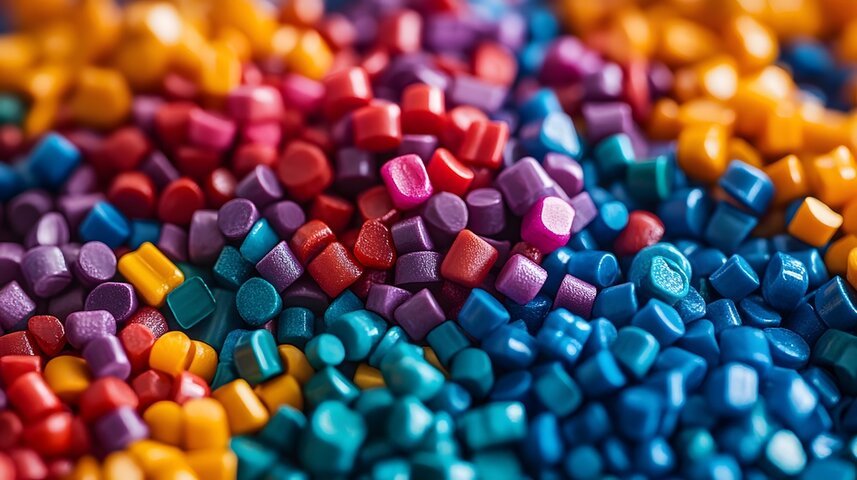
Polyethylene (PE)
Polyethylene (PE) is a lightweight and flexible plastic known for its resistance to moisture. It’s widely used due to its durability and ease of production.
Polypropylene (PP)
Polypropylene (PP) is tough, heat-resistant, and can endure repeated use. Its resilience to fatigue makes it one of the most versatile thermoplastics.
Polyvinyl Chloride (PVC)
Polyvinyl Chloride (PVC) can be either rigid or flexible. It’s known for being lightweight and flame-retardant, with excellent insulating properties.
Acrylonitrile Butadiene Styrene (ABS)
ABS is a strong, impact-resistant material. It has excellent machinability and maintains good dimensional stability, making it highly durable.
| Thermoplastic | Key Features |
| Polyethylene (PE) | Lightweight, moisture-resistant |
| Polypropylene (PP) | Heat-resistant, durable |
| Polyvinyl Chloride (PVC) | Flame-retardant, lightweight |
| Acrylonitrile Butadiene Styrene (ABS) | Impact-resistant, durable |
Nylon
Nylon is known for its strength, flexibility, and resistance to wear and abrasion. It is a durable thermoplastic that can handle friction well.
Polycarbonate (PC)
Polycarbonate (PC) is a tough, transparent material that offers excellent impact resistance. It is lightweight and easy to mold.
Polyethylene Terephthalate (PET)
PET is a strong and lightweight plastic with moisture-resistant properties. It is also notable for being recyclable.
| Thermoplastic | Key Features |
| Nylon | Strong, flexible, wear-resistant |
| Polycarbonate (PC) | Impact-resistant, transparent |
| Polyethylene Terephthalate (PET) | Lightweight, recyclable |
Acrylic
Acrylic is a clear and shatter-resistant thermoplastic, often used as a substitute for glass. It is known for its excellent weather resistance.
Teflon (PTFE)
Teflon, or PTFE, is known for its non-stick properties and high resistance to heat and chemicals. It has a low-friction surface and is chemically inert.
| Thermoplastic | Key Features |
| Acrylic | Clear, lightweight, shatter-resistant |
| Teflon (PTFE) | Non-stick, heat and chemical-resistant |
Common Types of Thermoset Materials
Thermoset materials are known for their ability to form permanent bonds when cured, making them strong and heat-resistant. Below are some common types of thermoset materials.
Epoxy
Epoxy is a widely used thermoset known for its high strength and excellent adhesive properties. It cures into a durable, rigid structure that resists chemicals and heat. Epoxies are often used in coatings and composite materials for high-performance applications.
Polyurethane
Polyurethane can be flexible or rigid, depending on its formulation. It is known for its excellent insulation and impact resistance. Polyurethane is also widely used due to its versatility, ranging from foams to coatings and adhesives.
Silicone
Silicone is valued for its heat resistance and flexibility. It maintains stability across a wide temperature range, making it suitable for demanding applications. Its flexibility and biocompatibility also make it a popular choice in medical devices.
| Thermoset Material | Key Features |
| Epoxy | Strong, chemical-resistant |
| Polyurethane | Versatile, impact-resistant |
| Silicone | Heat-resistant, flexible |
Phenolic Resins
Phenolic resins are thermosets known for their high thermal stability and fire-resistant properties. These materials are commonly used in electrical insulators and high-temperature environments. Phenolic resins also offer good dimensional stability, making them ideal for precision applications.
Melamine
Melamine is a hard, durable thermoset material. It is resistant to heat and scratching, often used in laminates and kitchenware. Melamine retains its shape well even when exposed to extreme conditions, contributing to its widespread use in industrial applications.
Polyester Resins
Polyester resins are valued for their excellent mechanical properties and chemical resistance. They are often used in fiberglass composites, offering durability and flexibility. These resins cure into hard, stable structures that can withstand harsh conditions.
| Thermoset Material | Key Features |
| Phenolic Resins | Fire-resistant, stable under heat |
| Melamine | Durable, heat-resistant |
| Polyester Resins | Chemical-resistant, durable |
Urea-Formaldehyde
Urea-formaldehyde is a thermoset polymer with excellent adhesive properties. It is widely used in the production of particleboard and plywood. This material is known for its rigidity and ability to form strong bonds.
Vulcanized Rubber
Vulcanized rubber is created through a process that strengthens natural rubber by adding sulfur. This process increases the material’s elasticity, durability, and resistance to wear and tear. Vulcanized rubber is flexible but tough, making it useful in automotive and industrial applications.
| Thermoset Material | Key Features |
| Urea-Formaldehyde | Rigid, strong bonding properties |
| Vulcanized Rubber | Elastic, wear-resistant |
Applications: Where Are They Used?
Thermoplastic Applications
Consumer Goods
Thermoplastics are everywhere in our daily lives. They're used in:
Toys
Toothbrushes
Storage containers
Water bottles
These products benefit from thermoplastics' durability and recyclability.
Automotive Industry
Car manufacturers love thermoplastics. They're used for:
Dashboards
Interior trim
Bumpers
Fuel tanks
Thermoplastics help reduce vehicle weight, improving fuel efficiency.
Packaging
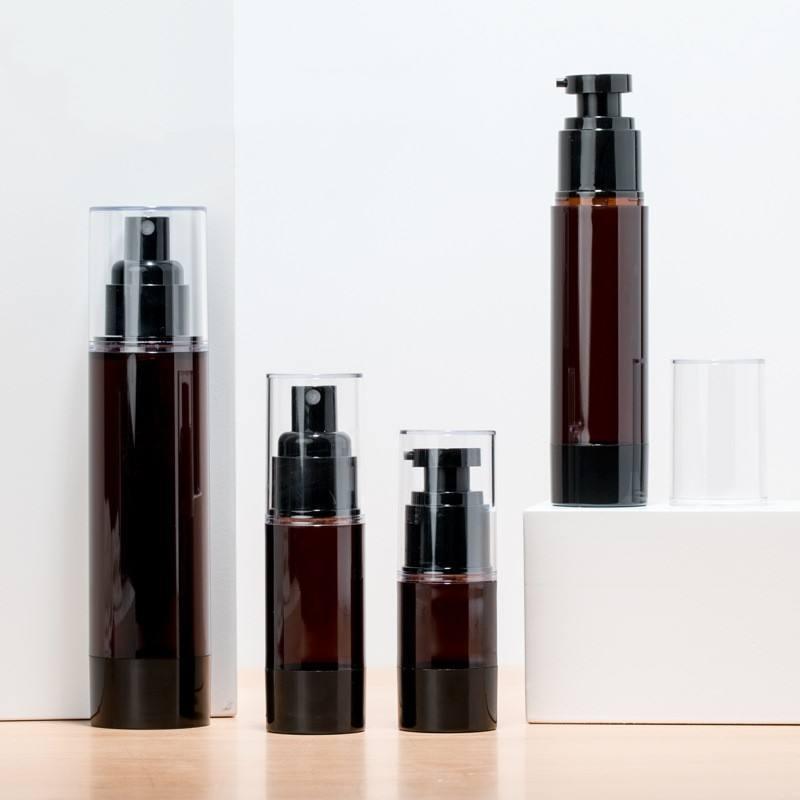
Sourcing from U-nuo's Airless Plastic Brown Empty Lotion Pump Bottles
The packaging industry relies heavily on thermoplastics. They're used in:
Food containers
Beverage bottles
Plastic bags
Protective wraps
Their flexibility and moldability make them ideal for packaging.
Medical Devices
Thermoplastics play a crucial role in healthcare. They're used in:
Syringes
IV bags
Surgical instruments
Prosthetics
Their biocompatibility and sterilization capabilities are invaluable in medical applications.
Electrical Insulation
Thermoplastics provide excellent electrical insulation. They're used in:
Wire coatings
Electrical connectors
Switch housings
Circuit boards
Their non-conductive properties ensure safety in electrical systems.
Piping Systems
The construction industry relies on thermoplastic pipes. They're used for:
Thermoplastics resist corrosion and are easy to install.
Textiles and Fibers
Synthetic fabrics often use thermoplastic fibers. They're found in:
Clothing
Carpets
Ropes
Upholstery
These fibers offer durability and easy care properties.
Thermoset Applications
Aerospace Industry
Thermosets are critical in aerospace. They're used in:
Their high-temperature resistance and strength-to-weight ratio are crucial.
Electrical Components
The electronics industry relies on thermosets. They're used in:
Circuit boards
Insulators
Transformers
Switches
Thermosets provide excellent electrical insulation and heat resistance.
Construction Materials
Thermosets are integral to building materials. They're used in:
Countertops
Flooring
Insulation
Roofing materials
Their durability and weather resistance make them ideal for construction.
High-Temperature Environments
Thermosets excel in extreme heat. They're used in:
Brake pads
Engine components
Industrial ovens
Furnace linings
Their ability to maintain properties at high temperatures is unmatched.
Adhesives and Sealants
Many industrial adhesives are thermosets. They're used in:
Automotive assembly
Aerospace bonding
Construction joinery
Marine applications
Thermoset adhesives provide strong, durable bonds.
Coatings
Protective coatings often use thermosets. They're applied to:
Automotive finishes
Industrial equipment
Marine vessels
Architectural structures
These coatings offer excellent protection against corrosion and wear.
Composite Materials
Thermosets are crucial in composites. They're used in:
Thermoset composites offer high strength and low weight.
Advantages and Disadvantages
When choosing between thermoplastics and thermosets, it's crucial to understand their strengths and weaknesses. Let's dive into the pros and cons of each material type.
Advantages of Thermoplastics
Thermoplastics offer several benefits:
Recyclability: They can be melted and remolded multiple times. This makes them eco-friendly and cost-effective.
Versatility: Thermoplastics are highly customizable. They can be easily shaped into various forms and designs.
Corrosion Resistance: They stand up well against chemicals and corrosive substances. This makes them ideal for many industrial applications.
Flexibility: Thermoplastics offer good impact resistance. They're less likely to shatter or break under stress.
Easy Processing: They can be easily processed using various methods. These include injection molding, extrusion, and thermoforming.
Disadvantages of Thermoplastics
Despite their benefits, thermoplastics have some drawbacks:
Heat Sensitivity: They can soften and lose shape at high temperatures. This limits their use in high-heat environments.
Limited Applications: They're not suitable for all uses. Heat-sensitive applications are particularly challenging.
Cost: Thermoplastics are often more expensive than thermosetting polymers. This can impact project budgets, especially for large-scale production.
Lower Strength: Compared to thermosets, they generally have lower strength-to-weight ratios.
Advantages of Thermosetting Plastics
Thermosets bring their own set of advantages:
Strength: They boast a high strength-to-weight ratio. This makes them ideal for structural applications.
Heat Resistance: Thermosets maintain their properties at high temperatures. They're perfect for demanding environments.
Chemical Resistance: They offer excellent resistance to chemicals and corrosion. This extends their lifespan in harsh conditions.
Dimensional Stability: Thermosets retain their shape under stress. They're great for precision components.
Complexity: They're suitable for creating complex, high-precision parts. This is particularly useful in aerospace and electronics.
Disadvantages of Thermosetting Plastics
However, thermosets aren't without their limitations:
Non-Recyclable: Once cured, they can't be melted or remolded. This makes them less environmentally friendly.
Brittleness: Thermosets are generally more brittle than thermoplastics. They're more prone to cracking under impact.
Machining Challenges: They're difficult to machine and finish. This can complicate manufacturing processes.
Limited Shelf Life: Some thermoset resins have a limited shelf life. They may require special storage conditions.
Aesthetics and Finishing
Surface Finish Capabilities of Thermoplastics vs Thermosets
Thermoplastics are known for their high-quality surface finish. They can achieve smooth, polished surfaces without extensive post-processing. This makes them ideal for products that require an attractive, finished look right out of the mold. Thermoplastics can also support various textures and patterns during molding.
In contrast, thermosets provide an even greater level of control over surface finishing. They can create intricate textures and patterns directly in the mold. However, once cured, thermosets are more challenging to modify or polish. Their harder surface makes them less flexible for additional post-processing but provides a durable finish.
| Material | Surface Finish Capabilities |
| Thermoplastics | Smooth, polished, easy to mold into patterns |
| Thermosets | Intricate, hard surface, more durable |
In-Mold Coating and Painting for Thermosets
One unique advantage of thermosetting plastics is the ability to use in-mold coating and painting. Before the resin is injected, coatings or paints can be sprayed directly into the mold. This creates a strong bond between the paint and the material, preventing flaking, chipping, or cracking. The result is a long-lasting finish with excellent adhesion.
In addition, in-mold painting allows for the creation of complex designs, from low- to high-gloss finishes. This makes thermosets an attractive choice when aesthetics are critical, and the finish needs to withstand harsh environments.
Aesthetic Considerations in Product Design
When designing products, aesthetics play a crucial role. Thermoplastics are favored for applications that require repeated handling or where appearance is key. Their ability to take on a variety of finishes, colors, and textures makes them versatile for consumer goods.
Thermosets, on the other hand, shine in industries that require a balance between functionality and aesthetic longevity. For example, thermosets can mimic finely detailed textures, even replicating the look of metals or wood. These plastics are often used when the product needs to maintain its appearance over time without degrading.
| Aesthetic Feature | Thermoplastics | Thermosets |
| Surface Flexibility | Multiple finishes, textures | Intricate patterns, limited post-molding work |
| Coating/Painting | Requires post-processing | In-mold coating, superior adhesion |
| Durability | May wear with use | Longer-lasting finish, resists cracking |
For more information on specific surface finishes and manufacturing processes, you might want to explore:
These finishing techniques are commonly used in various manufacturing processes, including injection molding and CNC machining.
Choosing Between Thermoplastics and Thermosets
Selecting the right material between thermoplastics and thermosetting plastics requires evaluating multiple factors. These include industry needs, costs, performance, and available processing methods. Below, we break down the essential aspects to consider.
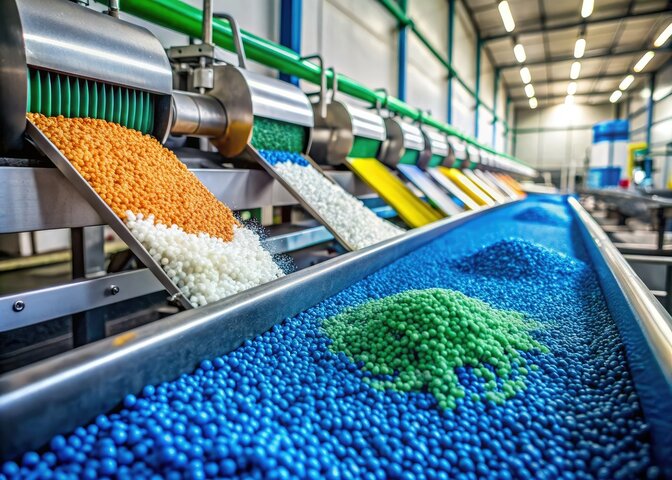
Factors to Consider
When choosing between thermoplastics and thermosets, it’s important to think about the end-use environment. Thermoplastics are better suited for applications where recyclability, flexibility, or reshaping might be needed. On the other hand, thermosetting materials excel in high-heat or high-strength scenarios due to their rigid structure and chemical resistance.
Additionally, consider production volume. Thermoplastics are easier and cheaper to process in high quantities. Thermosets may be better for low-volume, high-performance applications.
| Factor | Thermoplastics | Thermosets |
| Recyclability | Can be reshaped and recycled | Non-recyclable after curing |
| Heat Resistance | Lower, softens at high temperatures | Higher, maintains rigidity under heat |
| Production Volume | Cost-effective for high-volume runs | More suited for low-volume, specialized use |
Industry-Specific Considerations
Each industry has unique demands. In the automotive industry, thermoplastics like Polypropylene (PP) are favored for lightweight, flexible components such as bumpers or dashboards. Thermosets, such as epoxy, are used in areas requiring high durability, like under-the-hood parts that must resist extreme temperatures.
In electronics, thermosets provide superior electrical insulation, making them ideal for circuit boards and housings. Thermoplastics, like Polycarbonate (PC), are used in cases where transparency or impact resistance is needed, such as screens and displays.
Cost Analysis
From a cost perspective, thermoplastics are generally cheaper to process. Their recyclability makes them more cost-effective for large-scale manufacturing. However, thermosetting materials, despite having higher initial costs, often provide long-term savings in high-performance applications due to their durability and resistance to wear and tear.
| Cost Factor | Thermoplastics | Thermosets |
| Initial Cost | Lower, cheaper per unit | Higher, more expensive tooling |
| Long-term Costs | Cost-effective for mass production | Saves costs in high-performance, low-volume runs |
Performance Requirements
Performance demands also play a big role. Thermoplastics are great for applications requiring flexibility, impact resistance, and the ability to be recycled. However, thermosetting materials provide excellent dimensional stability, high heat resistance, and mechanical strength that thermoplastics simply cannot match.
When structural integrity and resistance to deformation are key, thermosets outperform thermoplastics. For example, in aerospace, where materials must withstand both extreme stress and temperature, thermosets are the preferred choice.
Processing Methods Available
Thermoplastics are easier to process using a wide range of techniques, such as injection molding, blow molding, or extrusion. These methods allow for fast, cost-efficient production. Thermosetting plastics, in contrast, require more specialized methods like reaction injection molding (RIM) or resin transfer molding (RTM). These methods ensure the material cures correctly, forming a permanent, rigid structure.
| Processing Method | Thermoplastics | Thermosets |
| Common Methods | Injection molding, extrusion | Reaction injection molding, compression molding |
| Production Speed | Fast, suitable for high-volume production | Slower, more suited for precision components |
Conclusion
Thermoplastics and thermosets have distinct properties. Thermoplastics can be melted and reshaped, while thermosets remain solid when heated.
Choosing the right material is crucial for success. Consider factors like heat resistance, strength, and processing methods.
Thermoplastics excel in recyclability and flexibility. Thermosets offer high heat resistance and dimensional stability.
Your specific application will guide your choice. Always weigh the pros and cons to make the best decision for your project.
FAQs About Thermoplastics vs Thermosetting Materials
Q: Can thermoplastics be recycled?
A: Yes, thermoplastics can be recycled. They can be melted and reshaped multiple times without changing their chemical structure.
Q: Why are thermosets preferred in high-temperature applications?
A: Thermosets maintain their shape at high temperatures. They have strong crosslinks that prevent melting, making them ideal for heat-resistant applications.
Q: How do thermoplastics and thermosets differ in terms of cost?
A: Thermoplastics are often more expensive initially. However, they can be recycled, potentially reducing long-term costs.
Q: Can thermoset materials be reshaped after curing?
A: No, thermosets cannot be reshaped after curing. Once set, they maintain their shape permanently due to chemical crosslinking.
Q: Which material type is more environmentally friendly?
A: Thermoplastics are generally more environmentally friendly. They can be recycled and reused, unlike thermosets.
Q: How do thermoplastics and thermosets compare in terms of durability?
A: Thermosets are typically more durable. They offer better heat and chemical resistance, maintaining their properties in harsh conditions.
Q: Are there any hybrid materials that combine properties of both thermoplastics and thermosets?
A: Yes, hybrid materials exist. Some combine thermoplastic and thermoset properties, offering unique characteristics for specific applications.
Q: What industries benefit most from using thermoset materials?
A: Aerospace, automotive, and electronics industries benefit greatly. Thermosets' heat resistance and strength make them ideal for these sectors.
Q: How does the manufacturing process differ between thermoplastics and thermosets?
A: Thermoplastics are melted and shaped. Thermosets undergo a chemical reaction during curing, permanently setting their shape.
Q: Can thermoplastics replace thermosets in all applications?
A: No, thermoplastics can't replace thermosets everywhere. Each has unique properties suited for specific applications.
Q: How do thermoplastics and thermosets differ in their resistance to chemicals?
A: Thermosets generally offer superior chemical resistance. Their crosslinked structure provides better protection against chemical attacks.
Q: What are the main differences in molecular structure between thermoplastics and thermosets?
A: Thermoplastics have linear or branched structures. Thermosets form three-dimensional networks through crosslinking during curing.
Q: How does the strength-to-weight ratio compare between thermoplastics and thermosets?
A: Thermosets typically have a higher strength-to-weight ratio. Their crosslinked structure provides greater strength at lower weights.
Q: Are there any specific safety considerations when working with thermoplastics vs thermosets?
A: Both require proper handling. Thermoplastics can release fumes when heated. Thermosets may produce harmful vapors during curing.
Q: How do thermoplastics and thermosets perform in extreme weather conditions?
A: Thermosets generally perform better in extreme conditions. They maintain their properties in high heat and harsh environments.











